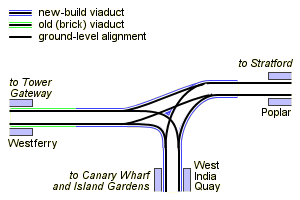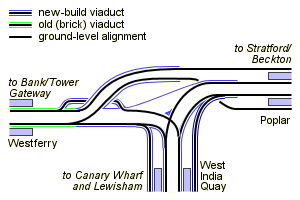Docklands Light Railway : Routes : City (Bank/Tower Gateway)

DLR's branch to the City of London, with termini at Bank and Tower Gateway, is the system's main connection with the rest of London's transport network, carrying substantial numbers of commuters whose journey to Docklands begins on another mode of transport. In addition, there is commuter traffic in the opposite direction, as the DLR provides a direct link to the City from suburbs such as Lewisham, Greenwich and Beckton.
Most of this section of the system uses former railway brick-built viaduct, opened in 1840 as part of the London and Blackwall Railway. This has been augmented by new viaduct at Tower Gateway and from Westferry towards West India Quay and Poplar, and a tunnel section added to Bank.

[select a station for pictures]
Tower Gateway and Bank
Tower Gateway station was the original DLR City terminus. It sits on new-build viaduct alongside the London Tilbury & Southend (LTS) mainline railway line, a little east of Fenchurch Street. The location and style of construction illustrates the planning ethos of the original DLR network, which was to build something as quickly and cheaply as possible, get it running as soon as possible, and extend it later if needed. The station is on Minories, near the Tower of London and on the very fringe of the City of London. It was essentially built at the end of the available railway viaduct, with minimal property aquisition and demolition. As a result, transport connections are far from ideal, with Fenchurch Street mainline station and Tower Hill on the District and Circle Underground lines both being a short walk away.
Tower Gateway's inadequacies as the DLR's City terminus were recognised before it was opened. In 1985 an Act of Parliament was deposited, allowing for the building for an extension to a new terminus at Bank. Royal Assent was received in November 1986, nine months before Tower Gateway opened.
Bank station is in deep tube, and is part of the London Underground station which also serves the Central, Northern and Waterloo & City lines. Monument station on the District and Circle lines can also be reached by a foot tunnel link. There are two DLR platforms at Bank, one for arrivals and one for departures. The running tunnels extend some way west of the station, terminating under Lothbury, forming a headshunt for reversing trains. On leaving Bank to the east, trains run in tunnel to a point just past Tower Gateway station, before surfacing and climbing up to the the viaduct used by Tower Gateway services.
City–Shadwell and Limehouse
At this point the two DLR tracks join the LTS viaduct, which they share with two mainline railway tracks, as far as Limehouse. There is an intermediate station at Shadwell, whose platforms necessitate a slightly widened viaduct.
The viaduct along this section of the route carried four mainline railway tracks until the construction of the DLR, and the supports for the mainline railway overhead line equipment still span the width of the viaduct.
Limehouse–Westferry
At Limehouse the DLR and LTS routes diverge, with the DLR taking the formerly disused London & Blackwall railway route east. There is third side to the junction here, an east-to-north viaduct which is still disused. East from Limehouse passengers catch their first glimpse of Docklands, in the form of Limehouse Basin on the right-hand side. This area, at the end of the Regents Canal, has been transformed from dereliction to an area of exclusive housing and moorings for pleasure craft.
Trains also pass through some less glamourous residential areas—not all of the East End has seen the sort of redevelopment and regeneration. Alongside the exclusive apartments and wharehouse convertions are some of the poorest areas of London.
Westferry–West India Quay/Poplar
The last station on the original railway viaduct is Westferry, near the northern entrance to the Rotherhithe Tunnel. This station straddles the junction of a number of streets, which complicated its construction. Shortly after this station the old viaduct comes to and end, and the track alignment begins for the West India Quay delta junction.
The original layout at the delta junction was a simple elevated triangle junction with tight curves. Trains from the City taking the left fork (the north side) for Poplar and the right fork (the west side) for Canary Wharf and Island Gardens. However this layout changed for the Beckton extension, to reduce conflicting train movements. Eastbound trains from Westferry to Canary Wharf and Lewisham now leave the original brick viaduct shortly after Westferry, moving onto a new high-level viaduct which takes them up to the original delta junction. Trains to Poplar and Beckton carry on a little way further before swinging off on another new viaduct, under the Canary Wharf viaduct, then over Aspen Way and the eastern entrance to the Limehouse Link tunnel and onto Poplar station. In the opposite direction, trains from Poplar use the same route, but trains from Canary Wharf use their original alignment, which is reduced to a single track in parts. The north face of the delta junction is now trackless.
| West India Quay delta junction | |
| Not to scale—not all crossovers shown | |
 |  |
| Original layout of delta junction | Present-day layout |
Page generated in ≈ 0.0025 seconds


















